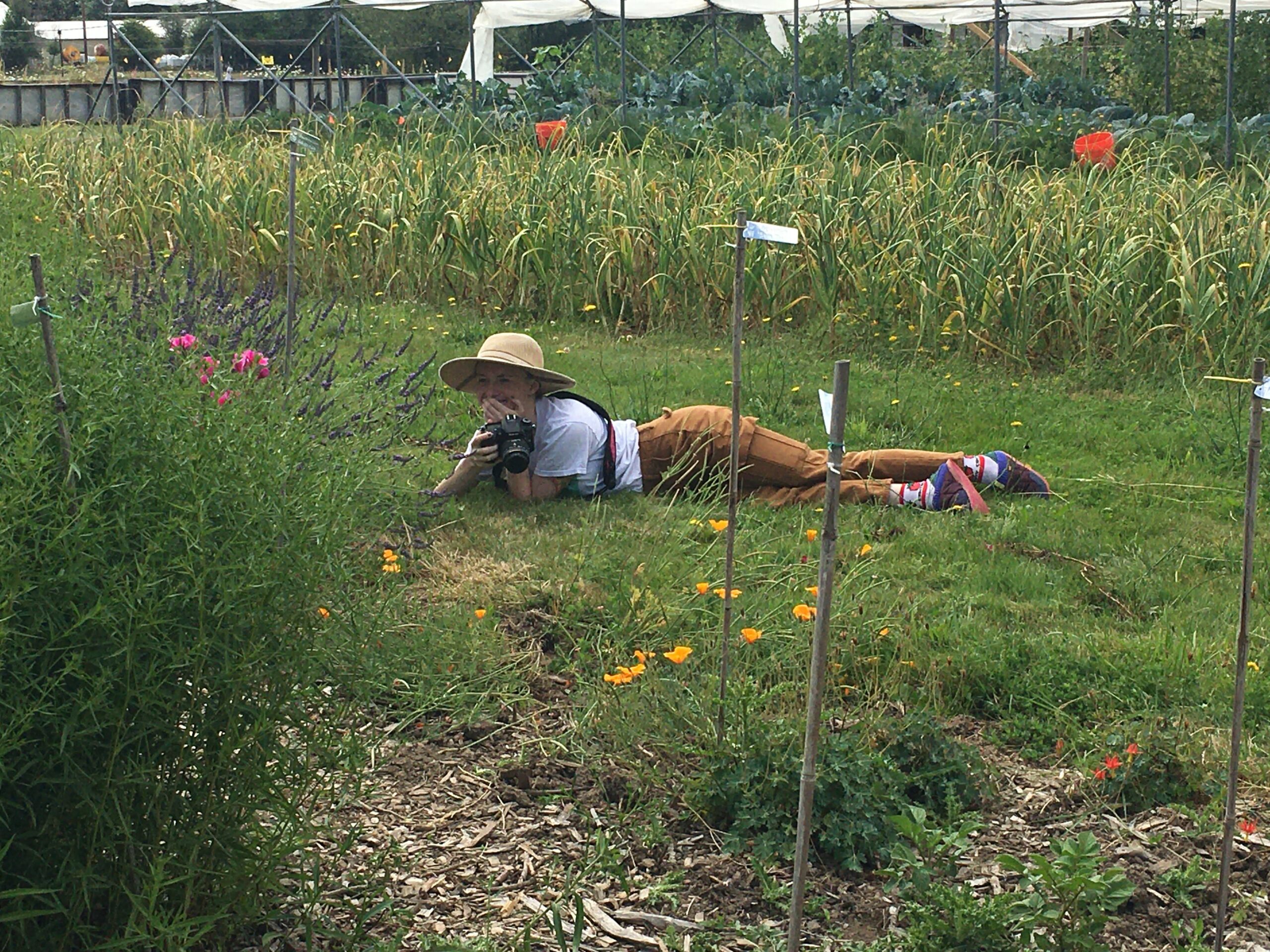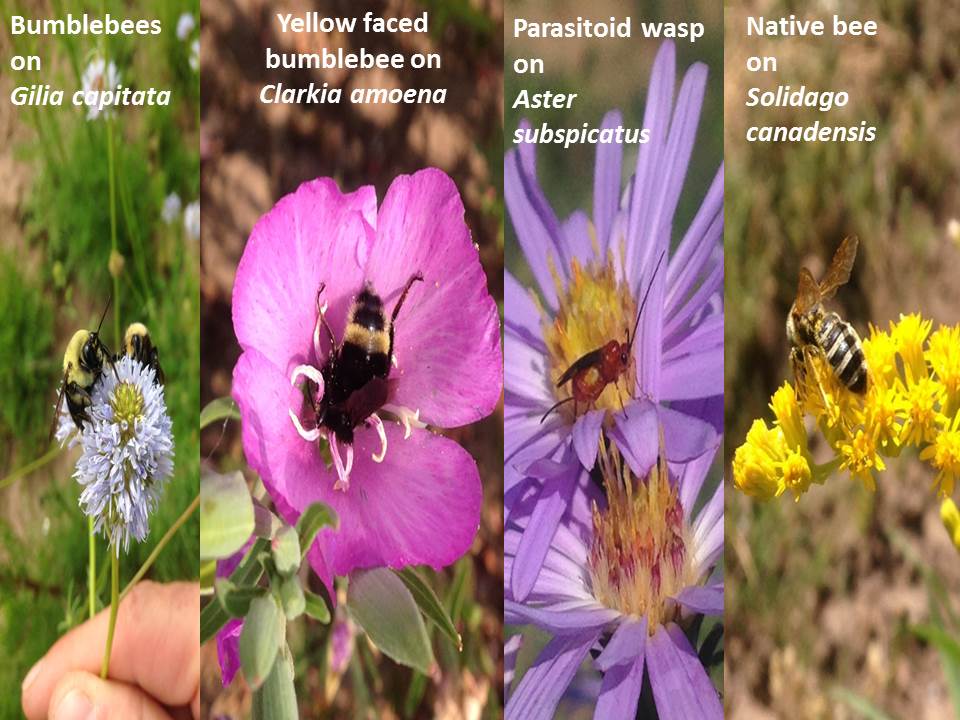This summer we completed our third and final field season surveying pollinator visitation to native plants and native cultivars! We will maintain our experimental garden for one additional season, to finish up some plant measurements and data collection missed in our initial three seasons. This post will serve as a 2022 field update in addition to summarizing some of our preliminary results from our field observations!
Study Plants (2020-2022)
| Photo | Scientific Name | Common Name | Plant Type |
|---|---|---|---|
 | Achillea millefolium | Yarrow | Native |
 | Achillea millefolium ‘Calistoga’* | Yarrow | Cultivar |
 | Achillea millefolium ‘Salmon Beauty’ | Yarrow | Cultivar |
 | Achillea millefolium ‘Moonshine’** | Yarrow | Cultivar |
 | Aquilegia formosa | Western Red Columbine | Native |
 | Aquilegia x ‘XeraTones’ | Cultivar (hybrid) | |
 | Camassia leichtlinii | Great Camas | Native |
 | Camassia leichtlinii ‘Caerulea Blue Heaven’ | Great Camas | Cultivar |
 | Camassia leichtlinii ‘Sacajawea’ | Great Camas | Cultivar |
 | Symphyotrichum subspicatum | Douglas’ Aster | Native |
 | S. subspicatum ‘Sauvie Sky’ | Douglas’ Aster | Cultivar |
 | S. subspicatum ‘Sauvie Snow’ | Douglas’ Aster | Cultivar |
 | Clarkia amoena | Farewell-to-spring | Native |
 | Clarkia amoena ‘Aurora’ | Farewell-to-spring | Cultivar |
 | Clarkia amoena ‘Dwarf White’ | Farewell-to-spring | Cultivar |
 | Clarkia amoena ‘Scarlet’** | Farewell-to-spring | Cultivar |
 | Eschscholzia californica | California Poppy | Native |
 | E. californica ‘Mikado’ | California Poppy | Cultivar |
 | E. californica ‘White’ | California Poppy | Cultivar |
 | E. californica ‘Purple Gleam’** | California Poppy | Cultivar |
 | Nemophila menziesii | Baby Blue Eyes | Native (California) |
 | N. menziesii ‘Penny black’ | Baby Black Eyes | Cultivar |
 | N. menziesii ‘Snow White’ | Baby Blue Eyes | Cultivar |
 | Sidalcea asprella ssp. virgata*** | Rosy checkermallow | Native |
 | Sidalcea malviflora ‘Purpetta’*** | Cultivar | |
 | Sidalcea malviflora ‘Party Girl’*** | Cultivar |
**Added in 2021 to replace removed plants
***Discontinued after 2020 due to taxonomic inconsistencies
We conducted 5-minute visual observations on our study plants over three seasons. During these observations, we recorded all insects that interacted with a plant. These interactions included foraging, resting, basking, mating, etc. We recorded insect IDs to morphological group levels, as many bees are hard to identify to species in the field! We were able to identify common bumble bees, honey bees, butterflies, and a few other insects to the species level, but many were identified to groups for ease (e.g. ‘green bees’, ‘black bees’, ‘leafcutter bees’).
Field Season Stats
| Year | # Sample Dates | # Collected Pollinators | # Observed Pollinators |
|---|---|---|---|
| 2020 | 28 | 2159 | 6238 |
| 2021 | 33 | 2471 | 6225 |
| 2022 | 29 | ~2000 | ~4700 |
Is there a difference in native bee visitation to native plants and their cultivars?

Our initial graphs show a subtle preference for native types by native bees. Douglas’ Aster, California Poppy, Farewell to Spring, and Columbine (4/7) have higher visitation by native bees when looking at cumulative and mean counts. The difference is marginal for Douglas’ Aster, but trends for the other three plants are strong. The remaining three species (Yarrow, Baby Blue Eyes, Camas) are difficult to assess, based on these figures alone.
Across these seven species, we do see differences in visitation between natives (wild types) and native cultivars. Whether these differences are statistically significant, and whether there is a trend across all plant groups, remains to be seen!!!
Subscribe to the Garden Ecology Blog to receive future updates on native-cultivar research and more news from the lab.
I want to recognize my amazing Bee Team this year, as this field season would not have been possible without them! I am grateful for all of their hard work and their success in managing this project while I was away numerous times this season. They are thoughtful, inquisitive, and resourceful students, all of whom would make amazing lab or field technicians upon their graduation this spring! Nicole is not pictured below, but also deserves recognition for all her contributions to this project. Thank you all 🐝










6 Comments
Add Yours →Please sign me up for your Garden Ecology blog. Thanks!
Karen,
If you view the blog from a web browser on the computer, there should be a box on the right side of our blog where you can submit your email to subscribe to blog updates.
Achillea ‘Moonshine’ is not the species A. millefolium. It’s a hybrid between the species A. clypeolata and A. aegyptiaca var. taygetea. Calscape says its sterile so does it produce pollen?
https://www.missouribotanicalgarden.org/PlantFinder/PlantFinderDetails.aspx?taxonid=241832
https://calscape.org/Achillea-'Moonshine'-(Moonshine-Yarrow)?srchcr=sc5db9d8e601cb5
Lisa,
Thanks for that note on taxonomy. It’s often difficult to find the parents of cultivars, I’ll make sure to look into ‘Moonshine’ more.
Sterility is achieved through multiple methods… some plants produce no pollen at all, some plants produce pollen that is sterile. We have seen Moonshine produce pollen and bees collect pollen from it! Cara’s research would be great to explore if pollen production and sterility something you’re interested in.
Cam I subscribe to this blog?
Please add me to the distribution list for your blog.